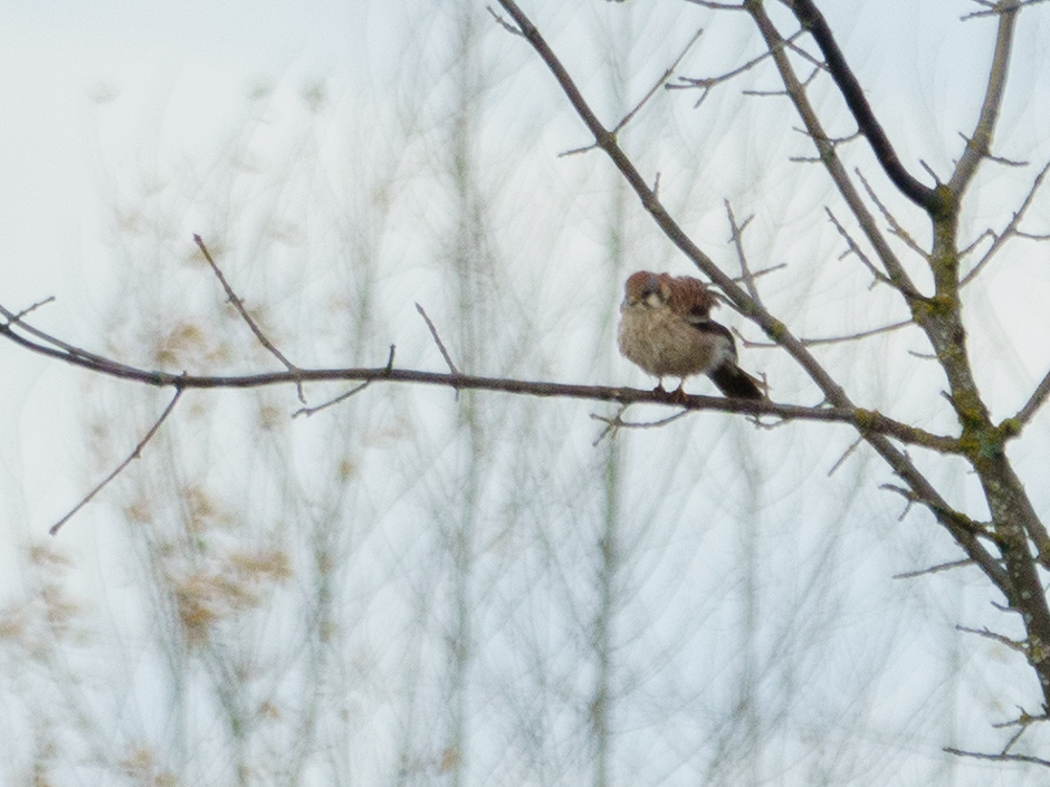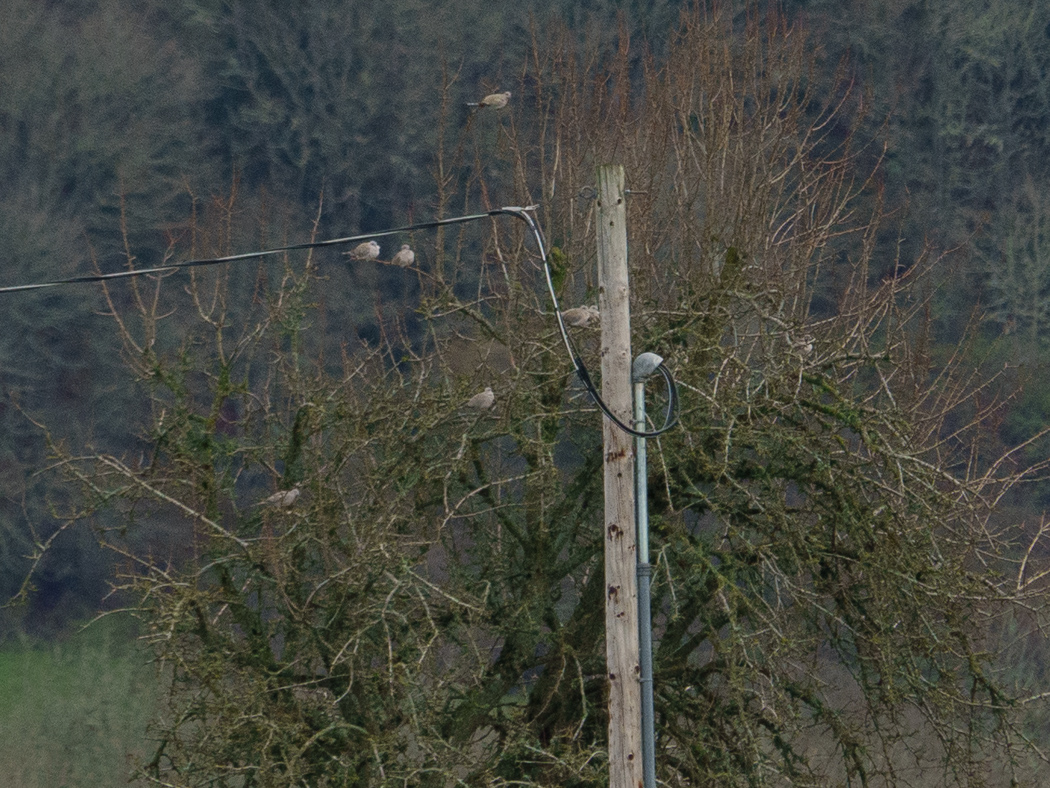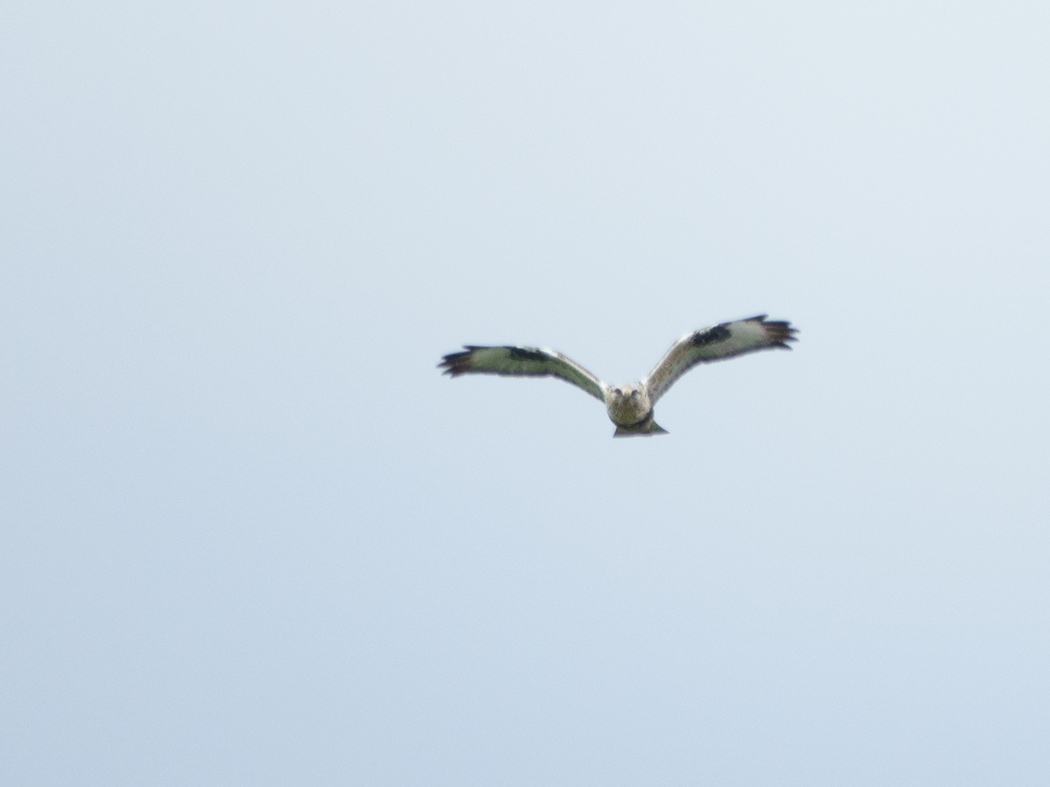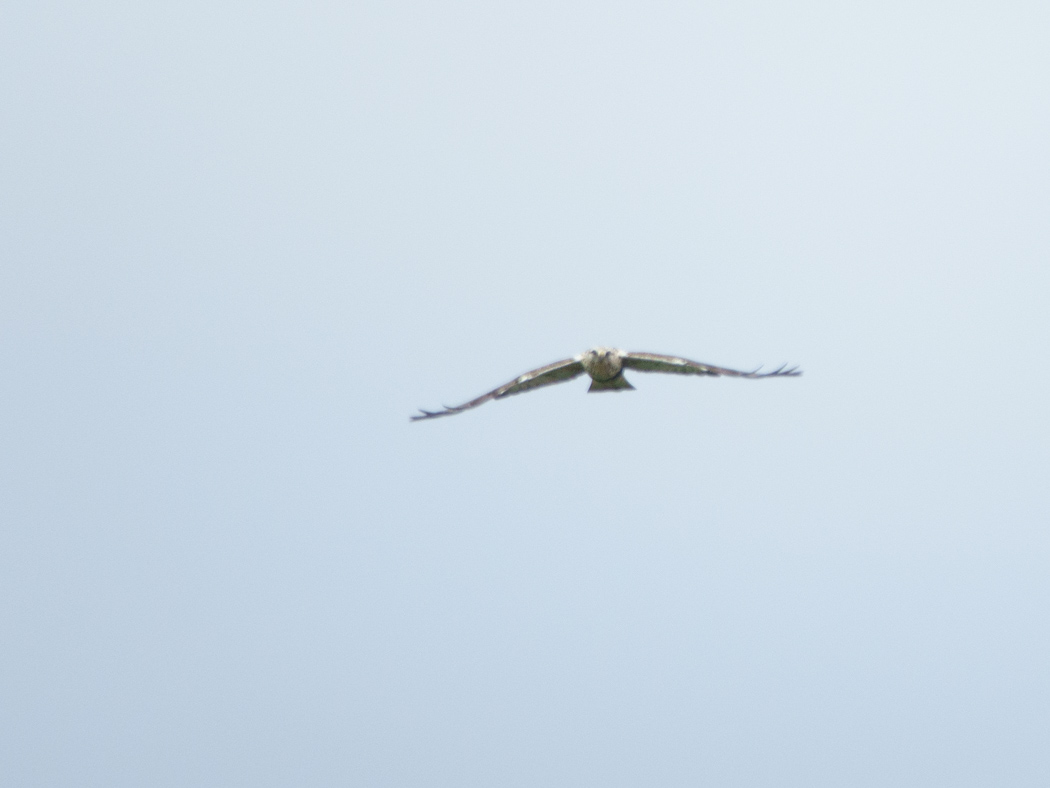- Web page: Priscilla Sokolowski
- Photographers:Priscilla Sokolowski
- Chris & Steve Kilpatrick
I'd like to thank everyone who came out
for this Raptor Run, and maintained an active interest through the afternoon until after 2:45pm!
Betsy and Jim;
Greg and Sharon;
Chris and Steve;
Your enthusiasm made this a trip a pleasure!
THANK YOU ALL!


The weather forecasts for the day of the Raptor run got better every day starting at 50% rain
predicted back on Monday to 11% to 20% forecasted the morning of the actual event.
The way it turned out we had a little bit of drizzle while we were driving up I-5
and otherwise we really didn't get rained on at all and we went on until 2:45 in the afternoon.
So rain wise we had a pretty good day and some pretty bright skies not a lot of sun but not dark either.
The temperature was a factor though. We all had a tough time with the cold wind that was blowing
anywhere we stopped in wide open areas - which was pretty much everywhere we stopped!
We had four cars; a total of seven people; this size group is very easily managed; and a pleasure to lead.
Betsy's husband Jim hadn't been on any of our Raptor runs before. He spotted lots of birds as we drove along
and obviously enjoyed himself.
At diamond Hill we stopped under the power lines and we're surprised to find bald eagles
perched on just about every power line pole. Most of them were adults. It was almost comical to see
so many of the powerline poles with Bald Eagles fixed on top of them like christmas ornaments for bird watchers.
There were also several Northern harriers flying low over the fields. There was a very cool wind blowing
BUT IT WASN'T RAINING!

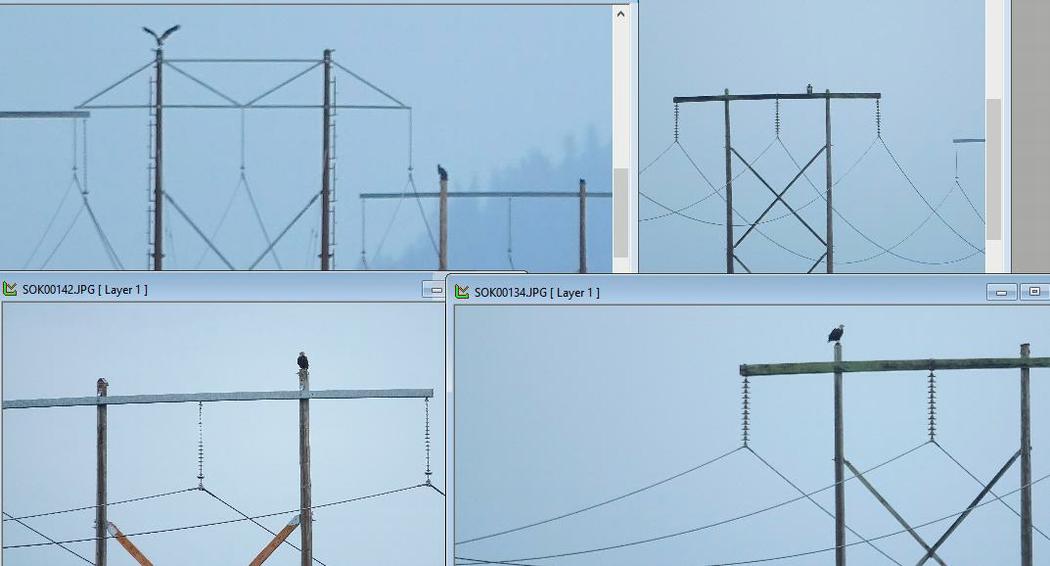




The Coburg Hills had a nice dusting of snow. Chris's landscape photo of the Diamond Hill area sets the stage
for an escape from the city and daily routines and plenty of relaxing scenic views.
As we drove to the gated driveway we came across a rough-legged hawk on the telephone pole next to the road
and I think everyone got a pretty good look at it. Steve got some exquisitely sharp photos of that bird!
From the gated driveway we saw some small birds some distance away in the Willows, which were difficult to identify
until we got pictures of them. One turned out to be a Northern Flicker and another was an American Kestrel.
We saw more Northern Harriers there and more Bald Eagles flying by. There were also some Northern Pintail Ducks
flying over the wetlands from time to time, landing in the various water impoundments.
It was nice to see the wetlands with water in the impoundments.
Joel Geier toldl us that the BELTS RD area is the largest remaining patch of native Willamette Valley prairie.
We drove a mile or two to Belts road. Along Belts Road we saw quite a few birds;
red-tailed Hawks and a couple Hawks we didn't identify that were flying;
A flock of what were possibly dunlin was flying a along Tub Run Creek.
Our cars were pretty spread out at that point with two cars out of sight behind us. They also reported (by radio)
a flock of possible Dunlin also flying along Tub Run Creek,
so we might have seen the same or different flocks. Once I got a close look at my photos,
the flock that I had seen near me turned out to have two dark necklace stripes across the upper breast
so it is safe to say they were killdeer. I'm not sure if enough details show on the dorsal view
to be able to ID them as Killdeer Rather than Dunlin.
Flying along Tub Run Creek, there was a flock of what we thought were Dunlin ...
But is this what Dunlin look like from the dorsal (top) view?
A closer look revealed the double black necklace of KILLDEER!
Another interesting thing happened at that same location some bird was singing very quietly
and it wasn't a familiar song to me it was really more like several mid-range pitch call notes than a song but then
there was a trill or a tremolo fairly low pitched for a songbird. It's not something I've heard before. It is pretty
rare for me to hear a bird making sounds I've not heard before (within western Oregon). It's possible the "song" and
the tremolo were different birds near to each other in the short trees (about 25feet high). I should have recorded it.
I didn't think of that at the time.
I'm thinking the tremolo might have been some kind of an owl. On the other hand Greg's wife heard it too
and she saw a woodpecker in the direction that the sound was coming from.
The bird wasn't terribly far away but it was still a very quiet song
and tremolo and they were just too many small branches in the trees to see much.

Several people commented on the beauty of the BELTS ROAD area, including Steve and Betsy.
I told them what Joel Geier told us; that this area is one of the largest remaining patches of Willamette Valley
Native Prairie. I hadn't taken an "open invitation" BOGS group to the Belts Rd area since 2018,
when Steve Barron and I led a raptor run.
Last Winter, Nov. 2020- Mar. 2021, while the Co-Vid pandemic was raging, I took several small "by invitation only"
groups on raptor runs through these areas. These were some of the folks I frequently go birding with
and three more seasoned folks; Dolly Marshall of WWII "plane-spotter" fame (and who spotted a Merlin for us);
and Jim and Sue Anderson, of Golden Eagle banding project fame;
and who had just moved to Eugene that year (2020) and who didn't yet know the birding habitats available to us.
Further along Belts Rd, near the new duck-hunting water impoundments, a possible Northern strike
was seen by Betsy and Jim and maybe a few others. There were a few more bald eagles at the water impoundments.
What we had hoped to see but did not see
was the giant flock of Dunlin that hang out there in winter every year. But we didn't stay at this location long
because the wind was particularly cold and nasty. Along the road though, in a tree near a house,
there were several very light-colored Mourning Doves in a small tree and they looked much like Christmas ornaments.
Not much turned up on bond Butte road except beautiful landscapes. The next two photos were
taken by Steve and Chris Kilpatrick respectively. The third one is by Priscilla.
Rowland Rd was a disappointment. Last year we had a lot of Hawks - including Rough-legged Hawks on the ground
in the fields along Rowland Rd, but on this trip we didn't see much.
We mostly saw Red-tailed Hawks on Lake Creek road.
Then we took a liesurely lunch break at the Halsey public park.
After lunch we went to the hotspot on Malpass road and hung out there for 45 minutes at least.
I've gone to the Malpass hotspot only one time - on a scouting trip a month ago.
On this trip we found the fields there to be pretty active with Harriers - both male and female -
Our first good sighting as we arrived there was a Rough-legged Hawk which approached us and then
fly by alongside of our cars.
In this first photo we can easily see one of the most obvious field marks of the light morph Rough-legged Hawk;
which are the dark and very rectangular-shaped carpal patches on the underside of the wings (out close to the wingtips).
These patches are also visible on the dorsal surface if you should get that kind of view. In my experience, the light morph
is the most common among the R.L. Hawks which Winter here. But the outer edges of these dark carpal patches
are also present on the dark morphs - again on both ventral and dorsal surfaces.
Northern Harriers were seen nearly constantly. Most of them were quite some distance away but two of them
allowed us to get closer photos.
I enlarged this photo beyond what its resolution allows, but did so to get as good as a view as possible
of what appears might possibly be a Short-eared Owl in the grass . Or it could be a cat!
It's still just not clear enough to be sure.
I will add that a Short-eared Owl was
reported from this site a few days after our visit.
A second photo of the same Harrier circling above the field. I hope these long-distance views of the open fields and
stands of trees and distant hills are restful to your mind. Spending a day in all these different fields of Linn County
puts me in such a relaxed almost trance-like state of mind. I always go home feeling calm and happy.
Steve K. snapped this very clear shot of a Northern Harrier with his long-lens camera as it flew past us.
As usual we did not see nearly as many male Harriers as females, but there was one flying fast and low across the field
shortly after we arrived and got out of our cars. It was quite a distance away and in this photo there is a black tarp
or something on the ground right behind the bird. Male Harriers are very light gray with darker "hoods" and black wing-tips.
It was one of those days where most of the birds we saw were far away. Even so, if you know the field marks
of a Rough-legged Hawk you can see the nearly-all-white tail and again the dark rectangular carpal patches on this
very distant Hawk flying above the treetops. In addition, Rough-legs tend to do a lot of hovering. They are the largest
Hawk we see in our area which hovers.
The Hawks were catching things too. Or at least they were seeing prey in the grass and diving after it.
Here's a female Harrier hitting the grass to catch a vole.
We did not see much evidence of sheep giving birth yet, and that is a known attraction
for the Wintering Bald Eagles. We did see a few fields with sheep grazing. Chris took
this next one, somewhere (I think) after leaving Malpass Rd and arriving at our more usual region
which begins at Creek / Smith Rds north of American Drive.
In past years we left Halsey driving west along American Drive (from the red-blinking 4-way stop-light)
and turned right off American Drive onto Creek. (I forget whether Creek is Road, Lane, or just Creek).
Once we make that turn the fields to the north are often pretty busy with various Hawk species. But
farmers sometimes leave a field without a crop for a season and that is the case along Creek this year
so very few Hawks were seen along Creek on our scouting trip or on this raptor run.
However, there is that stand of lonely and sad-looking trees close to where Creek ends with a "T" on Smith.
It's often the case that this stand of trees have a few raptors perched in them and that was true on this trip as well.
In fact there were quite a few Bald Eagles there this time. This was the most action we had all afternoon.
Two years ago on one of our BOGS raptor runs we flushed a Burrowing Owl as we drove past this little stream on County
Rd 211. This time I took this photo through my passenger window as I drove past the creek, hoping for the miracle
of a flushed Burrowing Owl again flying away ... but no such luck.
Our last photo from this trip is this triple-culvert along Blueberry Rd. These sheep had
gotten out of their fenced-in parcel and were having a party on the bridge.
We drove a few more miles and explored Davis Rd, but we just weren't seeing much
so at 2:45pm we disbanded and headed home. Everyone had a good time. The group
even gave me a round of applause for all my efforts - the maps and driving instructions
and leading the trip itself. It took 15 minutes from Davis Rd to the 4-way light at Halsey
(about 7 miles along Hwy 99E), and I was home in another 30 minutes, after taking I-5.
Questions about BOGS? EMAIL: priscilla@blog.priscillanhk.com
Generally if you want to know what is happening next at BOGS, or want to see the latest photos/reports,
you can find these on the HOME page:
http://priscillanhk.com/index.html
Enjoy!
Priscilla





















